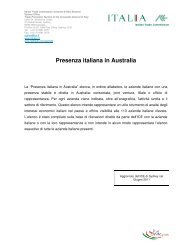Price Determination in the Australian Food Industry A Report
Price Determination in the Australian Food Industry A Report
Price Determination in the Australian Food Industry A Report
You also want an ePaper? Increase the reach of your titles
YUMPU automatically turns print PDFs into web optimized ePapers that Google loves.
Figure 10. Whole milk, 2 litre, supply cha<strong>in</strong> map<br />
Farmer<br />
Processor Market Logistics Retail<br />
Brand Ownership/Management<br />
receival consolidation<br />
distribution and logistics<br />
Farmer<br />
Processor<br />
Delivery<br />
Franchise<br />
Cha<strong>in</strong><br />
Retailer<br />
Consumer<br />
haul<br />
Wholesaler<br />
Independent<br />
and<br />
Convenience<br />
Retailer<br />
Approx. 11,000<br />
dairy farmers, but<br />
only 4000–5000<br />
share directly or<br />
<strong>in</strong>directly <strong>in</strong><br />
packaged milk<br />
market.<br />
• ‘Receival<br />
consolidation’ is<br />
where milk is<br />
consolidatd <strong>in</strong><br />
regional receival<br />
facilities and<br />
<strong>the</strong>n tankered<br />
to <strong>the</strong> necessary<br />
process<strong>in</strong>g<br />
plant.<br />
• Packaged milk uses about<br />
17% of <strong>the</strong> total market.<br />
• Three national processors<br />
with more than 80% of<br />
process<strong>in</strong>g market.<br />
• Up to 20 o<strong>the</strong>r small niche<br />
or regional processors.<br />
• Significant overcapacity<br />
(estimated at between 2 to<br />
3 times <strong>the</strong> market) exists<br />
<strong>in</strong> process<strong>in</strong>g sector.<br />
• Convenience market reta<strong>in</strong>s<br />
a strong share of packaged<br />
milk market.<br />
• Distribution strategies of<br />
dairy companies vary, with<br />
a mix of company-owned<br />
and outsourced or private<br />
route operators.<br />
• Major route to market is<br />
through franchised delivery<br />
bus<strong>in</strong>esses.<br />
• Role of separate wholesale<br />
sector is m<strong>in</strong>imal – only to<br />
provide paper-based<br />
trad<strong>in</strong>g on behalf of<br />
retailers, without tak<strong>in</strong>g<br />
title.<br />
• Cha<strong>in</strong> retail share of total<br />
market <strong>in</strong>creas<strong>in</strong>g to more<br />
than 55% of retail volumes.<br />
• Increas<strong>in</strong>g share of private<br />
label product <strong>in</strong> cha<strong>in</strong> and<br />
<strong>in</strong>dependent (IGA) retail. In<br />
cha<strong>in</strong> retail estimated at<br />
more than 60%.<br />
• Steady <strong>in</strong>crease over time<br />
<strong>in</strong> low-fat modified milks<br />
which have 27% of volume<br />
(whole milk has 56%).<br />
DAIRY – ANALYSIS OF PACKAGED MILK PRICING<br />
<strong>Price</strong> <strong>Determ<strong>in</strong>ation</strong> <strong>in</strong> <strong>the</strong> <strong>Australian</strong> <strong>Food</strong> <strong>Industry</strong> A <strong>Report</strong><br />
Retail prices for milk<br />
Historic regulated milk prices at retail were set on a cost-plus basis. Costs built up through <strong>the</strong><br />
cha<strong>in</strong> to provide each sector with a deemed appropriate marg<strong>in</strong> which was justified on a costrecovery<br />
basis.<br />
S<strong>in</strong>ce <strong>the</strong> removal of price regulation, retail prices have broadly fluctuated around those historic<br />
levels with gradual <strong>in</strong>creases over time. However, strong price competition rema<strong>in</strong>s between<br />
retailers, between major cha<strong>in</strong> retail and <strong>in</strong>dependent stores and across <strong>the</strong> beverage category.<br />
Retail versus farmgate pric<strong>in</strong>g analysis<br />
The dairy <strong>in</strong>dustry has emerged from a recent history where regulation supported a practice of<br />
sett<strong>in</strong>g different prices for ‘manufactur<strong>in</strong>g’ (for milk used <strong>in</strong> manufactured dairy products) and<br />
‘market milk’ (for milk used <strong>in</strong> packaged liquid milk products) at <strong>the</strong> farmgate level.<br />
The major adjustment for <strong>the</strong> <strong>in</strong>dustry was mov<strong>in</strong>g from a production-push pric<strong>in</strong>g culture <strong>in</strong>to an<br />
environment where <strong>the</strong> returns of <strong>the</strong> processor and producer were very directly exposed to <strong>the</strong><br />
consumer market realities of <strong>the</strong> fresh dairy category.<br />
An analysis of <strong>the</strong> history of farmgate versus retail supermarket pric<strong>in</strong>g over <strong>the</strong> past six years is<br />
conta<strong>in</strong>ed <strong>in</strong> <strong>the</strong> chart below which illustrates pric<strong>in</strong>g for a 2 litre whole milk product.<br />
The farmgate price <strong>in</strong> <strong>the</strong> chart below is a farmgate price calculated as <strong>the</strong> average paid by<br />
packaged milk processors.<br />
22







